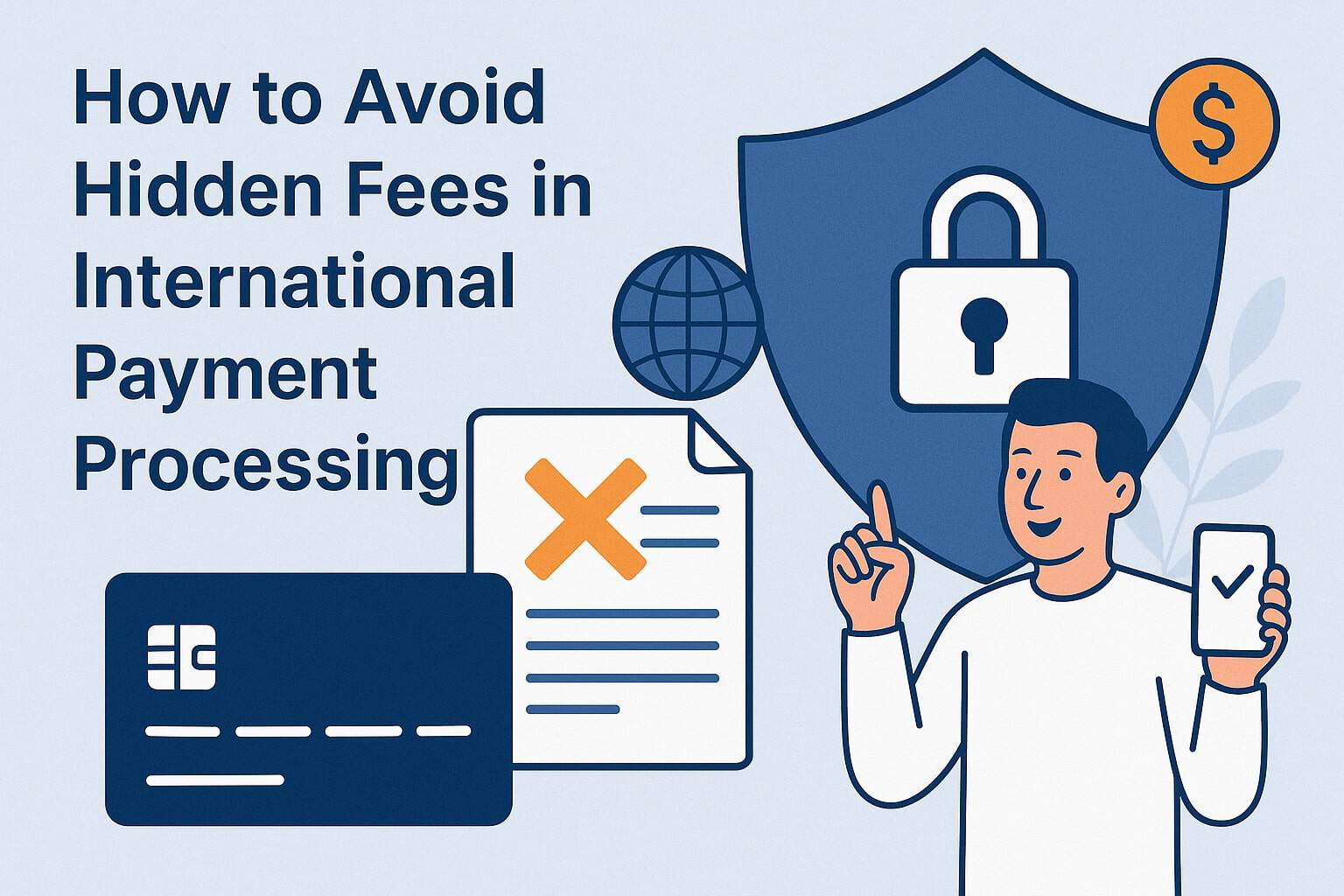
By crossborderfees October 11, 2025
International payment processing is a necessity for businesses conducting transactions across borders. However, hidden fees often catch merchants and customers off guard, shrinking profit margins and undermining trust.
This guide explores in detail how to avoid hidden fees in international payment processing, what causes them, and what best practices and strategies can guard against unexpected charges. Use this updated, optimized, and reader-friendly guide to keep your cross-border payments transparent and cost-efficient.
Understanding Hidden Fees in International Payment Processing

When dealing with cross-border transactions, several types of fees may lurk beneath the surface. Knowing what to look for is the first defense against hidden costs. Here, we explain the common categories of hidden fees, why they occur, and the terminology you must be familiar with.
Types of Hidden Fees
Hidden fees in international payment processing can take multiple forms, including:
- Foreign exchange (FX) markups / spreads: Processors often apply a spread or markup on the interbank exchange rate, meaning you pay more than the mid-market rate.
- Flat transaction fees: A fixed amount per transaction, e.g. $0.30 or €0.25, even when sending in currency different from yours.
- Percentage transaction fees: A percentage of the transaction amount, often varying with the payment method (credit card, bank transfer, etc.).
- Cross-border fees / international service fees: Additional charge for processing transactions across national borders.
- Conversion fees: If funds must be converted to another currency, a conversion fee may apply even if the merchant already uses that currency.
- Intermediary or correspondent bank charges: For wire transfers, intermediary banks in the chain may deduct their own fees.
- Receiving bank or collecting bank charges: The recipient’s bank may deduct fees before they credit the account.
- Settlement and reconciliation fees: Charges for settling funds or reconciling transactions, especially with multiple currencies.
- Chargeback or dispute fees: If a dispute arises, fees may be imposed for handling disputes across geographies.
- Inactive or maintenance fees: If accounts or payment gateways remain inactive, you may be charged maintenance fees.
These hidden costs, when aggregated, can significantly erode margins — sometimes adding 3%–5% or more to your expense on each international transaction.
Why Hidden Fees Exist
Hidden fees exist for several reasons:
- Profit models of processors: Payment processors and banks may capture revenue via margins or surcharges that are not transparently disclosed.
- Complex routing and intermediaries: International payments often traverse multiple banks; each may deduct its charge.
- Currency conversion is opaque: Many processors don’t reveal their FX spread or mark it up heavily.
- Lack of regulation or inconsistency by region: Some markets allow more flexibility in charging hidden fees.
- Complex fee structures: With tiered pricing, multiple add-on services, intermediaries, and optional features, fee structures become nontransparent.
Understanding the motive and mechanism behind hidden fees is vital for avoiding them.
Key Terms You Should Know
- Interbank rate / mid-market rate: The rate at which banks exchange currencies among themselves; the benchmark your FX markup is compared against.
- FX spread / markup: The difference between interbank rate and the rate you get; often expressed as a percentage.
- Correspondent bank: A bank that processes part of a transaction in an international chain.
- Onshore vs offshore settlement: Onshore settlement occurs within the local banking system; offshore settlement may require cross-border transfer.
- SWIFT / wire transfer codes (e.g., SWIFT, IBAN, BIC): Identifiers of banks and accounts used in international transfers; errors here may incur penalties.
- ECCNs, AML/KYC compliance fees: Additional charges arising from compliance with anti-money laundering or export controls.
- Routing fees / network fees: Costs associated with passing data through payment networks (e.g., Visa, Mastercard) across jurisdictions.
- Multicurrency wallet / settlement account: A feature offered by some processors to hold funds in multiple currencies to avoid conversion.
By knowing these categories and terms, you are equipped to scrutinize fee disclosures and ask the right questions of payment providers or banks.
Best Practices to Avoid Hidden Fees

To limit or eliminate hidden fees in international payment processing, adopt the following best practices. This section offers actionable and up-to-date strategies for businesses and individuals.
Choose Transparent Payment Providers
One of the most effective ways to avoid hidden fees is to partner with processors or fintech platforms known for transparency:
- Look for “no FX markups” or “interbank rate + fixed fee” models: Some providers explicitly offer interbank rates and charge a fixed transparency fee instead of markup.
- Check published fee schedules: A reputable provider openly publishes all fees (e.g., conversion, cross-border, settlement).
- Review sample invoices and statements: If possible, request sample statements to see how fees are itemized.
- Read customer reviews about unexpected fees: Real user experiences often reveal hidden costs that promotional materials omit.
- Negotiate volume discounts: High transaction volume can give you leverage to negotiate lower FX spreads or waive certain fees.
Transparency is the foundation — if the provider’s fee structure is confusing or incomplete, that’s a red flag.
Use Local Currency Billing When Possible
Whenever feasible, bill your customers in their local currency (so called “local currency pricing” or “local currency settlement”). This shifts the currency conversion to the payer’s side and reduces your exposure to FX conversions and markups. It also avoids cross-border surcharges and conversion of funds before distribution.
Of course, you must confirm your processor or acquiring bank supports local currency billing across your markets. Use multicurrency wallets or accounts to collect funds without forced conversions. This way, funds remain in local currency until you choose to convert them — often under better conditions.
Minimize Intermediary Banks
Each correspondent or intermediary bank in a transfer chain may deduct fees. To avoid this:
- Choose banks with direct relationships: Prefer banks or providers that maintain direct correspondent banking partnerships in destination countries.
- Use banking routes with fewer hops: The fewer nodes in the transaction route, the fewer fees charged.
- Use alternative networks: Some international payment services or fintechs bypass traditional SWIFT routing and avoid correspondent fees.
- Request “OUR” billing in wire transfers: In the SWIFT payment message you can set the cost option: “OUR” means you (sender) absorb all fees (though it may be expensive), “SHA” means split, and “BEN” means beneficiary absorbs. Use the one appropriate for your scenario.
By reducing intermediaries, you cut down one of the primary sources of hidden charges.
Monitor Exchange Rates and Timing
FX spreads and conversion timing materially affect how much hidden cost you incur. To manage this:
- Lock in rates when volatility is high: Use forward contracts or hedging tools to lock favorable exchange rates ahead of time.
- Avoid converting funds daily: Frequent small conversions accumulate spreads — batching conversions can mitigate this.
- Convert when the interbank rate is strong: Monitor rate trends and choose conversion windows when spreads tighten.
- Use real-time rate alerts: Many platforms offer real-time alerts when FX rates hit favorable thresholds.
By being strategic about timing, you reduce spread losses and avoid surprise costs.
Consolidate and Batch Payments
Instead of processing each small transaction separately, batching payments by currency or region can yield several advantages:
- Lower fixed fee impact: One flat fee for a batch rather than multiple micro-fees.
- Better negotiation power: Larger aggregated volumes make it easier to negotiate lower percentage fees or waived costs.
- Simplified reconciliation: A fewer number of payment entries means fewer chances of hidden or misapplied charges.
- Reduced currency conversions: Batch funds in one currency and convert in bulk under more favorable terms.
Consolidation is especially helpful if you operate in multiple markets; group payments by currency when possible.
Use Multicurrency Accounts and Virtual Accounts
Many modern banking platforms and fintechs offer multicurrency accounts or virtual accounts:
- Hold multiple currencies: You can receive, hold, and transact in multiple currencies without conversion.
- Internal transfers in the same currency: Moving funds internally among your accounts without crossing borders reduces costs.
- Virtual local accounts: These assign you local account numbers in foreign markets; payments arrive like local transfers, avoiding cross-border fees.
- Automatic settlement options: Some providers settle funds in a preferred currency only when you choose, instead of automatic conversion.
This infrastructure helps you dodge unnecessary conversions, markups, and cross-border fees.
Negotiate and Audit Fee Terms
Never accept a “take it or leave it” pricing model. Best practices include:
- Negotiate spreads and fixed fees: Use your transaction volume as leverage to reduce FX markup or transaction percentages.
- Ask for fee caps or ceilings: Put a ceiling on FX spreads (e.g. no more than 1%) or per-transaction fees for high volumes.
- Include audit rights: Contractually include the right to audit how your fees are applied.
- Periodic renegotiation: Reassess terms every 6–12 months to ensure they remain competitive.
- Benchmark against competitors: Use pricing of other processors as leverage to renegotiate your deal.
Vigilant contract negotiation and review can reveal hidden clauses or future fee escalations.
Match Payment Method to Fee Profile
Different payment methods carry different hidden costs:
- Bank wires / SWIFT transfers: Prone to intermediary and receiving bank charges.
- Credit/debit card payments: Higher percentage fees, potential foreign transaction surcharges, and chargeback risk.
- ACH / SEPA / local bank transfers: Usually lower cost (if available in your markets).
- Digital wallets / e-wallets: Vary by provider; check currency conversion, withdrawal, and cross-border fees.
- Cryptocurrency / stablecoins: In some use cases, crypto can bypass traditional FX and intermediary fees, but volatility, regulation, and compliance risk remain.
By matching the method to the destination and amount, you reduce hidden costs. For example, use local transfer rails or SEPA in Europe rather than card rails when possible.
Advanced Strategies and Tools
Once you implement foundational practices, you can layer on more advanced techniques and tools to further reduce hidden fees and optimize international payment processing.
Use Payment Gateways with Dynamic Currency Conversion (DCC) Awareness
Dynamic Currency Conversion allows the payer to see prices in their own currency at checkout. This is convenient, but:
- DCC often includes hidden markups: The rate offered is usually inflated.
- Offer choice: Let customers choose whether to accept DCC or pay in your base currency.
- Disable DCC in markets with strong local currencies: In some regions, DCC is heavily abused.
- Monitor DCC margins: Ensure the DCC provider’s markup is acceptable.
Being aware of and controlling DCC practices can prevent surprise conversion costs for you and your customers.
Leverage FX Hedging and Forward Contracts
To guard against fluctuations and hidden currency costs:
- Forward contracts: Lock exchange rates ahead of time for known future payments or receipts.
- FX options / caps / collars: Limit downside risk while retaining upside potential in rate movements.
- Natural hedging: Match foreign currency revenues with expenses in the same currency (e.g. paying a vendor in the currency in which you receive sales).
- Netting: Offset receivables and payables in a given currency so only net amounts are transferred.
These tools reduce exposure to hidden spreads and volatility penalties.
Use APIs and Automation for Monitoring
Modern systems allow real-time monitoring of payments, fee breakdowns, and anomaly detection:
- API integration with payment processors: Pull detailed transaction data to flag unexpected charges.
- Automated reconciliation systems: Match actual fees versus quoted in bulk and identify discrepancies.
- Alerting rules: Trigger alerts when a transaction’s fee exceeds a threshold.
- Visibility dashboards: Monitor spend by region, payment method, and currency to spot cost outliers.
Automation gives you visibility and control, reducing reliance on trusting opaque provider statements.
Apply Audit and Compliance Tools
Hidden fees sometimes arise from compliance costs (e.g. AML, KYC, export controls). You can mitigate these:
- Pre-validate beneficiary banks and accounts: Catch routing or compliance errors in advance to avoid penalty or fees.
- Embed compliance costs in pricing model: Rather than absorbing, you may allocate a minimal compliance buffer.
- Use compliance platforms or services: Ensure your provider employs best practices so you aren’t penalized later.
- Document all fee disclosures: Maintain contract and invoice archives to dispute any unexpected charges.
By proactively managing the compliance side, you reduce surprise compliance-driven fees.
Use Regional and Local Payment Providers
In many regions, local payment networks or fintech firms offer lower fees:
- Local acquiring banks / PSPs: These can offer lower cross-border charges by handling settlement locally.
- Regional fintechs: Often optimized for your target markets with reduced FX costs.
- Partnerships with local banks: Use local banking rails for settlement instead of global SWIFT networks.
- Open banking / local instant transfers: In some countries, open banking rails are cheaper than traditional banking.
A hybrid approach combining global and local providers can yield optimal fee structures.
Regular Reevaluation and Benchmarking
Even after setting up optimized systems, the payments landscape evolves:
- Quarterly or semiannual review: Compare your current fees to industry standards.
- Benchmark with peers or industry rates: Contract benchmarking services to evaluate your provider’s cost structure.
- Stay informed of regulatory changes: Currency controls, foreign transaction regulation, or sanction regimes may affect fees.
- Maintain multiple providers: Use competition among providers as leverage and as a fallback.
Regular reevaluation ensures you stay ahead of creeping hidden fee increases.
Common Scenarios and How to Handle Hidden Fees

Let’s walk through specific scenarios you may face, along with recommended responses to avoid hidden charges.
Scenario: A Customer Pays via Credit Card in a Foreign Country
- Potential hidden fees: high FX markup, cross‐border card fees, dynamic currency conversion (DCC) surcharge, chargeback fees.
- Solution:
- Offer local payment methods (local credit card, e-wallet) in that country.
- Turn off DCC or give the option to pay in your base currency.
- Use a payment processor with minimal card cross-border fees and competitive FX spread.
- Negotiate card processing rates for international cards.
- Offer local payment methods (local credit card, e-wallet) in that country.
Scenario: Receiving Wire Transfers from Clients Overseas
- Potential hidden fees: intermediary bank fees, receiving bank fees, SWIFT routing costs, conversion charges.
- Solution:
- Use “OUR” instruction when appropriate (though more expensive).
- Choose providers or banks with direct correspondent relationships to destination countries.
- Use virtual local receiving accounts in foreign markets to avoid cross-border wires.
- Batch wires and minimize the number of transfers.
- Use “OUR” instruction when appropriate (though more expensive).
Scenario: You Must Pay International Vendors
- Potential hidden fees: cross-border wire costs, conversion markups, correspondent fees.
- Solution:
- Ask vendors to invoice you in your base currency; you pay via your local account or multicurrency wallet.
- Use international payment platforms designed for business payouts with clear fee structures.
- Hedge or lock in exchange rates before making large vendor payments.
- Match vendor currency (natural hedge) to your receipts in that currency to avoid conversions.
- Ask vendors to invoice you in your base currency; you pay via your local account or multicurrency wallet.
Scenario: Refunds or Chargebacks Across Borders
- Potential hidden fees: return fees, additional conversion costs, double settlement costs.
- Solution:
- Apply symmetric fee policies: if you charged a cross-border fee, clearly communicate refund methods.
- Use the same currency for refund to avoid double conversion.
- Negotiate with your processor to cap refund/chargeback fees or waive them in high volumes.
- Monitor chargeback patterns and regional risk to minimize frequency.
- Apply symmetric fee policies: if you charged a cross-border fee, clearly communicate refund methods.
Scenario: Low-value Micropayments Across Borders
- Potential hidden fees: flat fees dominate small transactions, conversion spreads swallow margins.
- Solution:
- Use local alternative payment methods tailored for small payments (mobile money, local wallets).
- Batch micropayments and settle in bulk.
- Use payment providers optimized for micropayments that have tiered or scaled pricing.
- Pass minimal fixed fee in your pricing rather than absorbing it entirely.
- Use local alternative payment methods tailored for small payments (mobile money, local wallets).
Frequently Asked Questions (FAQs)
Q1. What’s the difference between FX markups and hidden fees?
Answer: FX markups are a specific form of hidden fee: they are the added margin above the interbank rate during currency conversion. Hidden fees are a broader category including transaction fees, cross-border surcharges, intermediary charges, and more. When you see a large spread on currency conversion, that’s often a hidden FX markup.
Q2. How can I estimate hidden fees before choosing a payment provider?
Answer: Request a sample invoice or “all-in” quote listing (a) the FX rate used, (b) fixed transaction fees, (c) cross-border fees, (d) intermediary charges, (e) monthly or maintenance fees, and (f) any compliance or settlement fees. Compare that against competitor providers to benchmark cost.
Q3. Is it possible to avoid all hidden fees in international payments?
Answer: It’s unlikely you can eliminate them entirely—some minimal fees are intrinsic to cross-border infrastructure. However, you can reduce them dramatically by choosing transparent providers, minimizing intermediaries, using local rails, and negotiating aggressively.
Q4. Do cryptocurrency payments remove hidden fees?
Answer: Crypto can bypass traditional banking rails and avoid some conventional fees, but new risks arise: volatility, conversion costs when converting to fiat, regulatory compliance costs, and withdrawal fees. Use crypto only where it aligns well with your business model and after due diligence.
Q5. What’s “OUR,” “BEN,” and “SHA” in wire transfer instructions?
Answer: These are billing instructions in SWIFT payments:
- OUR: Sender pays all fees (payee receives full amount).
- SHA: Fees are shared (sender and receiver each pay).
- BEN: Beneficiary pays all fees (amount received is net of charges).
Choosing the correct option based on your relationship and agreement helps avoid surprise deductions.
Q6. How often should I renegotiate or audit my fee structure?
Answer: You should review your pricing and providers at least every 6 to 12 months. Benchmark against industry peers, audit providers for discrepancies, and use findings as leverage to renegotiate or switch providers.
Q7. Can small businesses benefit from these strategies?
Answer: Yes. Even small businesses can use multicurrency accounts, negotiate with processors, batch small payments, and choose local payment rails to minimize hidden fees. Many payment platforms now cater to small and medium enterprises (SMEs) with transparent fees.
Conclusion
Hidden fees in international payment processing can quietly erode profitability and create financial surprises. However, by understanding the types of hidden charges, recognizing the terms, and following best practices, you can significantly mitigate or even eliminate them.
Use transparent payment providers, bill in local currencies, minimize intermediary banks, monitor and negotiate FX spreads, batch payments, employ multicurrency accounts, automate fee monitoring, and regularly audit your agreements.
Though some minimal costs are unavoidable in cross-border finance, your objective should be to keep those costs predictable, transparent, and as low as competitively possible.
By executing the strategies outlined in this guide, you’ll position your business or operations to handle international payments confidently and cost-efficiently — without falling prey to hidden fees.